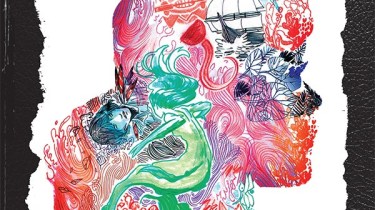The Wendy Project

One of the more unusual releases this past year uses the well-known story of Peter Pan to explore survivor’s grief. The Wendy Project is written by actress/screenwriter Melissa Jane Osborne and illustrated by Veronica Fish (Archie). Its black pebbled cover and rounded corners give it the feel of a sketch-filled notebook, fitting its concept.
Wendy was responsible for a car accident in which she skidded off a bridge and her brother Michael drowned. That’s what they tell her, anyway, but they haven’t found his body, and she thinks he was taken away, flying past the moon. Her therapist gives her a notebook in which to draw what she’s seeing, to process her thoughts about fairyland and whether or not she’s crazy. As she tries to continue on, her fantasies overlap her existence, as shown in this page at school.
The use of color is notable. Daily life after the accident is a washed-out brownish grey, but other moments, whether fantasy or memory, are vibrantly full-colored. The spot color of the notebook, in particular, in otherwise monochrome scenes, resembles a light source or an oozing wound, depending on tone. It’s not cleanly colored within the lines, but sloppy, spreading like water, refusing to hold the boundaries. Sometimes the art, and the hands that make it, is the only thing that seems real.
Wendy takes up with Eben Peters, a trouble-making classmate who invites her to a drinking party in the woods. He’s looked down on by her parents and authorities, but at least he’ll talk to her when everyone else leaves the crazy girl alone. And she still thinks she sees Michael, as a shadow, or a movement out of the corner of her eye.
By reworking the Peter Pan story from a female perspective, Osborne highlights the selfishness and pain of Neverland, of a place where women are forced to be caretakers and identity is lost along with memory. There’s no tomorrow, and Peter is “kind of a jerk.” Stories help us remember, and girls remember, but boys forget. So Wendy has to make her choice, whether to escape into fantasy or pick real-life people with all their flaws and problems.
The Wendy Project requires attention and thought and maybe even a couple of re-reads to glean all of its content. It’s challenging but rewarding, a wonderful way to process grief and having to say goodbye. (It’s also a terrific argument for why more older works should be public domain, so people can work with their well-known symbols in new ways.)
(The publisher provided a review copy.)


4:47 pm
It is not clear from your review, so I am wondering what age would this book be appropriate for?
Thanks!
4:56 pm
When a colleague reviewed it at Good Comics for Kids, they labeled it grades 7 and up. Aside from the death motif, I can’t think of a lot of other potentially objectionable content, other than the teen drinking party.